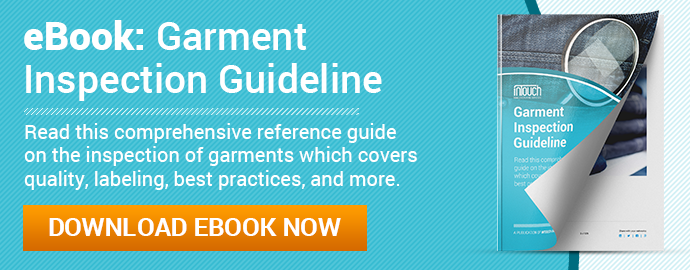In the garment industry, whether you are a manufacturer, importer, or brand, you must understand the importance of quality control in this business. This industry shifts swiftly, and any time lost in shipment or defect fixings can lead to unimaginable losses. Moreover, quality issues can quickly disseminate in the digital age, giving competitors an advantage. Therefore, quality control is essential, and quality inspection is the most commonly used method.
In this post, we will guide you through the steps of a garment quality inspection, the key checkpoints to focus on, and how can AQF expertise support your garment quality control.
What Is the Process of A Garment Inspection?
First, let's take a look at the process of garment quality inspection. Understanding this process will help you form a complete picture of this quality control method and grasp the focus of each session, which supports the delivery of final garments that meet your expectations.
1. Confirm Storage Condition
Per the information provided by your inspection order, the inspector will arrive at the inspection location on your required date. The inspector will check if the packed items are stored properly, in the correct quantity, and if they have with right shipping marks. This helps to ensure production progress, verify storage conditions, and estimate as precisely as possible the total quantity available for inspection.

2. Select Samples Per AQL Standard
The next step is to select random samples per the AQL (Acceptable Quality Limit) Inspection level. This is an international quality standard that outlines the worst tolerance of different levels of defects, critical, major, and minor, in the selected sampling items. It saves time and budget for an inspection. Of course, you may also require a 100% inspection on your batches if your products are of high value or you have zero tolerance for defects.
3. Check Packaging, Marking, and Labeling
Then, the inspector will check the shipper carton and inner carton’s markings and labelling to ensure the identification of the packages. The inspector will also check the retail packaging’s markings and labelling per your documents or instructions to ensure conformity.
For garment labeling, brands must adhere to specific requirements, which we will outline in the below session.
4. Verify Product Dimension and Weight
In this step, the inspector will first verify the dimensions and weight of the shipper carton to see if they match your requirements. This may help you to determine if the batches can perfectly fit in the container you booked. The inspector will measure the individual products as well in size and weight to see if the data matches your specifications.

5. Check Product Workmanship
In this step, the inspector will evaluate the overall workmanship of your products, looking at aspects such as appearance, cleanliness, workmanship, color fading, and so on. Any defects found will be categorized as critical, major, or minor. Additionally, if you have an approved sample, the inspector will compare the manufactured products with the approved sample to ensure that your supplier is maintaining the same production standard.
6. Conduct On-Site Tests to Validate Product Functionality
Last but not least is the field-testing step. The inspector will perform specific on-site tests according to the inspection checklists to test the functionality in real-life. For garments, common tests include the GSM test, seam strength test, color shade check, and more. The inspector can also perform other special tests based on your specific requirements.

What Checkpoints Are Included in A Garment Inspection Checklist
Professional third-party quality control companies use quality control checklists during product inspections. A quality control checklist, also known as an inspection criteria sheet (ICS), is a document that outlines product requirements, specifications, packaging, and inspection checks. It is one of the best tools to help identify defects and avoid errors in the manufacturing process.
Different product categories have different quality control checklists tailored to focus on specific aspects. Here we will talk about the key checkpoints in a garment quality control checklist and how they can help to ensure the quality of your garment products.
Product Specifications
- Material confirmation: check if the manufactured products are made of specified materials
- Workmanship and appearance: check on the overall workmanship of the selected garment pieces to identify defects like double stitches, untrimmed threads, and wrinkle marks.
- Color shade: inspectors will use a standardized color system, such as Pantone cards, to define the color of the garment and check if it aligns with your required color.

Packaging and Labelling
- Packaging: packaging is crucial in the garment retail chain, as it protects products from damage and must comply with local laws in the destination market. Packaging checks usually include packaging's weight and dimensions, material, carton size and weight, and retail packaging strength.
- Labelling: garments require labels. Garment labels not only help to establish a brand identity but also give instructions on how to care for this garment after purchase. Most importantly, the labels must comply with the rules and regulations in the destination market. According to the U.S. Federal Trade Commission (FTC), garments entering the U.S. market must have a care label that includes at least the following information:
- Fiber content (e.g. Cotton)
- Country of origin (e.g. Made in China)
- Washing and care instructions (e.g. Hand Wash)
- Manufacturer Identification, which is a Registered Identification Number (RN)
In addition, brands and manufacturers must ensure that care labels meet requirements regarding placement, size, and font.

Data Measurement
Checkpoints for data measurement can be various for different garment types. Take a sports shirt for example, here are some key measurement points that this session will cover:
- Body length for front and back
- Chest
- Neck width
- Front neck drop and back neck drop
- Shoulder
- Sleeve length
- Sleeve opening
- Placket width
- Shoulder forward
- Collar stand height
- Collar point length
On-Site Test
On-site tests help to define if the garment meets your specifications and quality standards. Depending on different garment types, on-site tests can vary. Here we have collected some general on-site tests for example:
- Abuse test
- Fabric weight test (GSM test)
- Stitches per inch check
- Colorfastness test
- Hand feeling test
- Metal detection test
- Needle damage test
- Lining pulling test
- Fitting test
- Function test
Secure Your Garment Quality with AQF Expertise
With over 17 years of dedicated experience in the quality control industry, AQF brings a wealth of expertise specifically tailored to garment and apparel quality control. Our comprehensive knowledge spans across various garment types, from fashion apparel to sportswear, lingerie, workwear, and beyond. Situated strategically in key garment manufacturing hubs such as China, Bangladesh, and Vietnam, our trained inspectors ensure prompt response and thorough inspections, reaching your supplier's factory within 48 hours. Our informative report with detailed images can provide you with a thorough review of your products manufactured overseas and support you in making informed decisions on production and shipment.
Trust us to safeguard your garment products' quality and compliance needs. Contact us today to discover how we can support your garment inspection requirements with efficiency and reliability.







